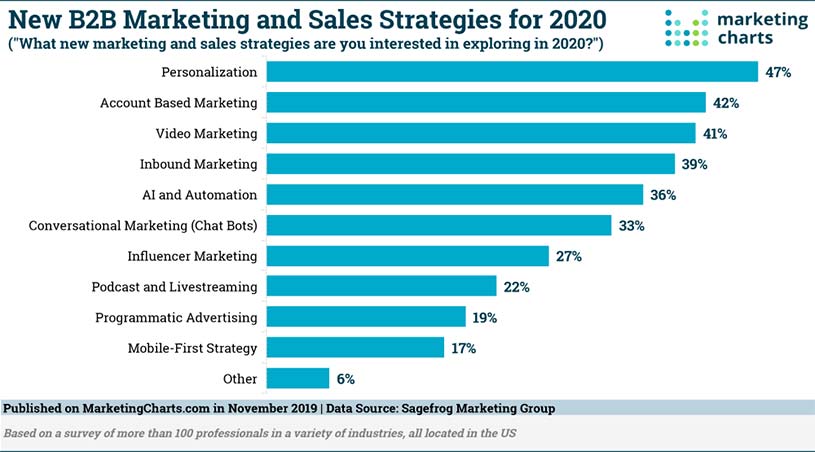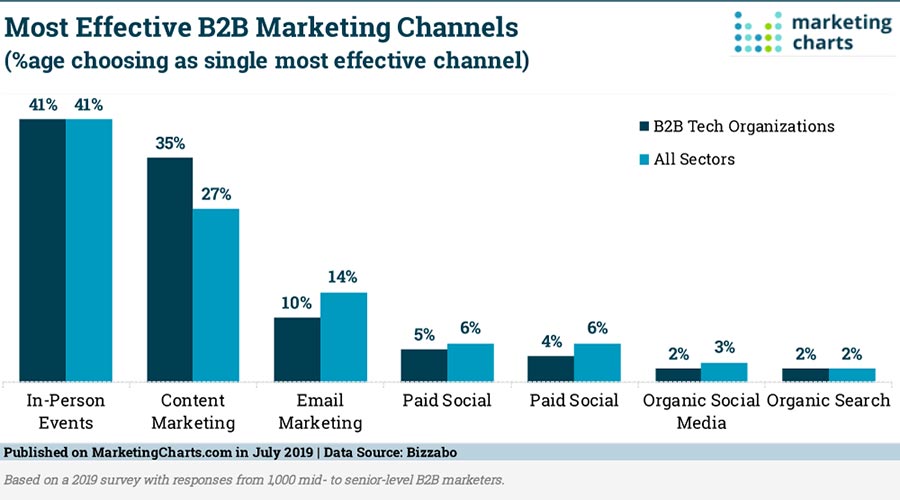9 B2B Field Marketing Strategies to Increase Revenue!

Table of Contents
As a field marketer, you are responsible to generate demand in your sales region. To generate demand, you need a field marketing plan. So, here are 9 B2B field marketing strategies to get you started!
A successful field marketing strategy includes activities such as account-based marketing, event marketing, lead generation, customer stories, and marketing analytics.
Let’s dive deeper and see what this means.
Watch the video below or continue reading.
Curious to learn what all the responsibilities of Field Marketing Managers are? Well, check out my recent article that explains what a Field Marketing Manager does.
1. Account-based marketing
Account-based marketing is an integral part of every effective field marketing strategy. As a field marketer, you are working closely with the sales organization.
Especially in B2B organizations, the sales team will often have a target account list. These are the top accounts to which they want to sell.
When it comes to account-based marketing, you really have 3 approaches:
- The one-to-many approach;
- The one-to-few approach;
- The one-to-one approach.
Generally, the global campaigns team will cover the one-to-many and one-to-few approaches.
The field marketing team will also focus on the one-to-few approach but mostly on the one-to-one approach.
With the one-to-one approach, you set up a team and together you create a plan to sell into a specific company. This will be the account where the sales see the highest deal potential. As you can imagine, the one-to-one approach is the most time consuming of them all.
It’s called account-based marketing but don’t be fooled. The account owner is the owner of the group. Other members such as field marketing, customer success, technical sales, and the channel team are support functions.
The field marketing team plays a critical role in the one-to-one account-based marketing team. As a field marketer, you have to create a plan to enrich the target account with relevant content. You have to create awareness campaigns and use your marketing analytical tools to track performance.
Always create a baseline first of the current situation. For example, how many people from that account you have in your database. As time progresses, you can update the team on the progress of your marketing contribution to the ABM team.
Account-based marketing is a field marketing strategy that is most exciting. I’ve also gained the most working experience from campaigns like this. It’s a lot of fun! So include it in your field marketing checklist.
As a matter of fact, 42% of marketers will adopt an account-based marketing strategy in 2020.

2. Event Marketing
The field marketing team will be the team responsible for selecting and managing external marketing events. These are events that you sponsor and you’d have to buy a sponsorship package.
With external events or also known as trade shows, there are two things that you must include:
- A keynote presentation;
- One-to-one meetings;
Why? Because by including these things, you will get more return on investment from B2B events. Whenever I book external trade shows, I always include these. I’ve actually written a detailed post about this and tips on how you can get more ROI from B2B events.
Your field marketing strategy will also include events that you host yourself. In successful field marketing, you will be hosting things such as:
- Executive dinners;
- Round table sessions;
- Breakfast or lunch sessions;
- Customer events;
- User groups.
With events such as these, there is something that you have to include on your field marketing checklist.
Always invite customers to these sessions. It’s incredibly powerful to let your prospects mingle with customers. Of course, they should be happy customers!
In general, it’s a field marketing best practice to market your customer success stories. Therefore, it has a dedicated point in this article. See point 5 below.
In-person events are considered to be the most effective marketing channel.
3. Awareness through Public Relations
As a field marketer, you are responsible for a certain region. It could be that your region is mature, or perhaps you are trying to penetrate a new market. It doesn’t really matter.
A key field marketing strategy is to generate awareness in the market that you’re representing. Of course, there are many ways to generate awareness. However, you should always be doing public relations.
In every region, there will be some publications that your target audience is predominantly visiting. It’s your job to get a lot of content posted on these publications and to drive some backlinks to your website. This will help you to get organic traffic to your website.
If you are not creating awareness of your company, then your competitors will. Especially, in B2B tech companies, the competition is fierce. If this is not in your field marketing checklist, then you will miss out.
So work together with your PR agencies and create a plan to create as much awareness in your region as possible. You can check the backlinks generated by your PR agency through tools such as Semrush.
4. Digital Lead Generation
It’s easy to rely on the global campaigns team to do your digital lead generation. However, you need to collaborate with them to come up with the best campaigns for your regions. After all, as a field marketer, you’re the regional marketing expert.
Complementary to the global marketing campaigns, you will also need to do your own digital lead generation.
Content syndication is often part of a field marketing strategy. It’s a great way to get your content in front of your target audience on external websites.
Oftentimes, B2B organizations work with external databases. Basically, you can purchase a list of contacts. Even in Europe with strict GDPR regulations, this is still possible through vendors such as I4Business. A database vendor often used in the US is Zoominfo.
Realize that these leads are cold as ice. As a field marketer, you should know how your target audiences behave in your region as well as the best strategies to warm them up.
So, work with your marketing operations team to create a nurture campaign for these leads. Include various nurture streams depending on their level of engagement and knowledge about your company.
5. Customer Stories
Your happy customers are your most valuable assets when it comes to demand generation. It’s much more powerful when your customers are talking about you than when you do it yourself.
You need to be working together with sales to develop customer success stories. You can then use this in your marketing mix.
Especially in B2B markets, your prospective customers want to learn about how your company delivered value in their industry. So for example, let’s say you’re talking to a prospect in the manufacturing industry. If you can show a customer success story in the manufacturing industry, this will help to make the conversation easier.
However, in B2B markets, it can sometimes be hard to get your customers to agree on writing a success story; especially if your company delivered value that sets them apart from the competition.
A way to combat this is to talk to your sales team. When sales close the deal, they can negotiate that a customer success story is part of the deal. This is usually agreed upon against a small discount on the final deal value.
If it’s part of the contract, then it will be much easier to come up with a customer success story.
Don’t limit yourself to customer success stories on your website though. A powerful field marketing strategy to get your customers to speak at external events. This is a way to get much more ROI out of a B2B event.
6. Localizing global marketing campaigns
Your global marketing team will develop many campaigns throughout the year. However, they often have no idea what is actually going on in regional markets.
Therefore, it’s your responsibility to closely collaborate with them in order to generate campaigns that are also relevant to your market.
However, there will always be campaigns that you have to optimize for your region. Sometimes you have to translate campaigns into your native language.
This is a relatively low effort for big impact. Your global campaigns team is doing most of the heavy lifting and all you need to do is optimize it and promote it locally.
Talk with your regional sales directors to set targets for your sales teams. For every campaign that we do, we give sales targets to drive a certain amount of campaign responses from their target account list.
A successful field marketing team can drive a lot of value from global campaigns. If you make global campaigns successful, the global campaigns team will be happy to help you with campaigns relevant to your market too! Win-Win!
7. Joint marketing with partners
In the field marketing department, you need to be thinking about scalability. Many B2B organizations collaborate with other companies. They have a common goal to generate as much business as possible.
There are many benefits that you gain by collaborating with partners:
- You can use each other's expertise to improve messaging;
- You can use each other's resources and databases;
- You're able to do more campaigns and events.
Let’s say your field marketing budget is $200k. You can spend that money on events, PR and campaigns. However, if you work together with partners, you can do joint campaigns.
This also means that you can split the costs. This is effectively increasing your local field marketing budget. Instead of doing 1 event, you now have the budget to do 2 events.
This means more leads and more business for your company.
8. Intent-based marketing
You know exactly what your prospects are doing on your website. You also know how they are engaging with your marketing campaigns.
How great would it be if you also know what they are researching on external websites?
Well, this is where intent-based marketing comes into play.
Intent-based marketing shows you what intent your prospects have. So let’s say you’re selling low-code software. If you see that your prospects are researching digital transformation or your competitors, you can now use this information in your messaging.
Intent-based marketing also compliments a one-to-one account-based marketing strategy. It’s incredibly valuable to understand what your target account is researching on external websites. You can use this information to supply solutions to their research questions.
With vendors such as TechTarget and Bombora, you can generate leads based on their research intent. So let’s continue the example of digital transformation. With vendors as TechTarget, they will supply you leads from your target accounts that are researching a certain topic.
Of course, these leads are very cold so you need a good nurture campaign to warm them up.
Intent-based marketing is a must in your field marketing strategy. It works so well together with account-based marketing. Increase your chances of ABM success and implement intent-based marketing.
9. Marketing Analytics
Marketing analytics should always be on top of your field marketing checklist.
You need to understand how your campaigns and events are performing. How are you going to make a decision to attend an event again if you don’t understand the return on investment?
You also need to understand how many marketing qualified leads you're generating. As well as, the marketing sourced sales pipeline you have generated.
As mentioned, event marketing is a critical part of field marketing. So for every event, you should be creating an event dashboard. I’ve written a post on how to create the perfect B2B dashboard.
In B2B organizations, you will also be exposed to Quarterly Business Reviews. In these reviews, you need to present your performance from the previous quarter. Of course, you also need to present your plan for the next quarter.
This is the place to show your performance and to improve your relationship with sales. However, refrain from presenting data such as MQLs generated. Why? Because sales don’t care.
Sales care about how much pipeline you have generated for them. So this is what you need to be presenting. However, this is only possible with proper reporting.
What’s your best field marketing strategy?

Share this article





Super smart and informative. Thank you!